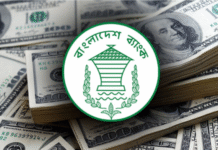
The health ministry’s development spending was stuck at a disappointing level even after 11 months of the outgoing fiscal year for its failure to accelerate expenditures when the public needed the most.
The health division used Tk 3,759 crore out of Tk 11,971 crore in the 11 months to May, which is only 32 per cent of the allocation made from the annual development programme, data from the Implementation Monitoring and Evaluation Division (IMED) of the planning ministry showed.
 For all latest news, follow The Daily Star’s Google News channel.
For all latest news, follow The Daily Star’s Google News channel.
Despite the government’s emphasis on the sector for the second year running amid the protracted pandemic, the expenses have been low.
“The health ministry has low capacity in utilising project aid. It is, however, okay when it comes to using the government fund,” said Pradip Ranjan Chakraborty, secretary of the IMED.
The health services division used up 48 per cent of the fund disbursed from the state coffer during the July-May period. It was 17 per cent when it comes to project assistance.

When the IMED asked the ministry about the low ADP implementation, it replied it was working, and good progress would be visible at the end of the fiscal year, Chakraborty said.
Khondaker Golam Moazzem, research director of the Centre for Policy Dialogue, said the low implementation rate of the division proved that the officials responsible for executing projects were not efficient and did not emphasise implementing the initiatives related to the health sector.
On June 9, Abdur Rouf Talukder, senior secretary of the finance division, said the money was never a problem in combatting the public health crisis. Still, the health ministry could not utilise the funds.
“I watched with surprise that the health ministry could not spend a major portion of the funds we gave them amid the pandemic,” he said at a seminar organised by the Bangladesh Institute of Development Studies.
Earlier, at the post-budget briefing, Talukder said the full amount could not be spent because of the problems in the procurement process and the inexperience of the project directors.
The overall ADP spending stood at Tk 122,231 crore in the July to May period, which was 58 per cent of the allocation. The outlay was Tk 115,421 crore during the same period a year ago.
“Overall, the implementation rate is one percentage point higher than last year,” Chakraborty said.
“The implementation will accelerate as the year comes to an end.”
According to Chakraborty, the current figure presented the financial progress.
“The physical progress has been 10 per cent higher than the financial progress on average,” the IMED secretary said.
The financial progress has been low as many bills remain pending and the ministries release funds after verifying the expenses, he said.
“The financial progress will go up once the bills are adjusted.”
Among the top 15 ministries that received the highest allocation, the local government division implemented 63 per cent of its development budget.
The roads, transport and highways division spent 59 per cent of the allocation, the power division 69, the railways ministry 59 per cent, the science and technology ministry 74 per cent, and the secondary and higher education division 54 per cent.
Other top achievers are the housing and public works ministry that used 44 per cent of the fund, the water resources ministry 60 per cent, the shipping ministry 49 per cent, the bridges division 72 per cent, the industries ministry 51 per cent, and the Prime Minister’s Office 51 per cent.









